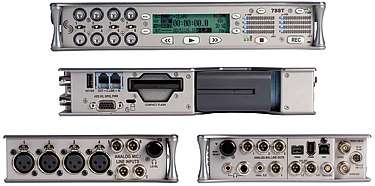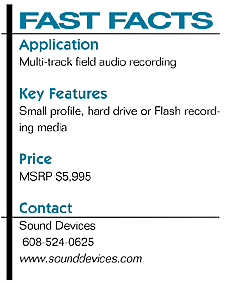Sound Devices 788T
It would have been hard to imagine, just a few years ago—an 8-track, timecode-locked field recorder in a small package that was affordable. Imagine no more! Sound Devices recently released their 788T to answer the needs of mobile video makers and feature film recordists. It's a four pound package that's easy to operate in even the most challenging conditions and yields the highest quality, multichannel sound recordings, timecode-locked to video.
FEATURES
The 788T has a very similar size, form factor, and functionality to the other members of Sound Devices' field recorder line. The unit itself measures about 1.8-by-10-by-6.4 inches—about the size of a small paperback book. It weighs in at about 3.6 pounds without the battery. Power requirements are fairly minimal: the unit can operate from a 7.2 volt, Sony L-type Lithium-ion battery (one included, and these are commonly and cheaply available) or an external AC (10-18 Volt), via a supplied Hirose-connected wallwart). The battery kicks in if the AC power falls below a set level. One coin sized 3 volt battery provides backup power for date and time; another provides backup for timecode settings.

The Sound Devices 788T recorder The unit records to the internal 160 GB SATA hard drive, an external hard drive, and/or CompactFlash cards, and can connect to a host computer (Macintosh or Windows) or external drive(s) via Firewire 400, Firewire 800, or USB 2.0. There are eight analog microphone inputs, four on XLR and four on TA3 connectors; all provide 48 volt phantom power, and provide level control, high pass, peak limiter and polarity. Input can also come from AES digital audio sources, available via a multi-pin connector on the back panel. Outputs are four channels of balanced line-level analog on TA3 connectors, two channels of unbalanced analog out on a 3.5 mm connector, four channels of AES on TA3, and two additional AES channels from the rear panel's multi-pin connector. The 788T can be clocked from external word clock or from video sync, and supports 23.976, 24, 25, 29.97 and 30 (drop and non-dropframe) rates.
Input level pots and channel arm switches are on the front panel for easy access, along with level and status indicators, very bright colored LEDs, a very clear LCD screen for status, timecode, channel routing, battery/power levels, and hard disk and/or CompactFlash card status. You set input levels by pushing the appropriate button once to pop it out, rotating, and pushing again to recess the button and prevent accidental changes. Transport buttons are along the bottom edge of the front panel. The 788T is a record-priority device, which means that it is always ready to begin recording with a single button push.
Channel assignments, as well as most of the recorder's functionality, are set from the menu system, and are accessible from front panel buttons and a side panel turn knob. The menu system is very detailed, not very deep and very easy to navigate. In addition, there are thoughtfully arranged groups of presets, for input and output channel assignments and headphone monitoring, which allow you to change configurations among easily set presets at the touch of a button.
The 788T can record on all eight channels at once, at sample rates of 32, 44.1, 47.952, 48, and 48.048 kHz, and 24- or 16-bits deep, with or without dither. The file format used for recording is Broadcast Wave (.WAV) either mono or poly files, but the unit can also read/play MP2 and MP3 files. When mono files are selected, each channel of each take yields a separate file; when in poly mode, each take yields an interleaved file of all channels for that take. Sound Devices' Wave Agent utility (free) can combine mono files into a poly file, among other tasks.
IN USE
Using this recorder is a pleasure. It is so well constructed and laid out that you can put most of your concentration onto what you're recording, rather than making sure the machine is operating correctly. I used the 788T on two different, but somewhat related, video projects during the time I had it for review. The first was recording second system sound directly from the mixing board during two nights of concerts I was shooting. A simple BNC cable and a menu setting were all that was necessary to slave the 788T to my Sony PMW-EX3 camcorder's timecode. I used all my available and sundry wireless rigs to send four separate channels from the board to the Sound Devices recorder, which was located next to my camera in the dark and distant balcony where I was shooting. One push of the record button and we were off and running. The level meters and LCD status display were incredibly easy to read in the dark. The input gain pots are surrounded by colored LEDs that reflect the status of each input: green for viable input, with an increase in brightness reflecting an increase in the signal's amplitude; red means the input signal has reached the user-defined peak threshold; yellow means the input limiter is engaged and active; flashing yellow means no viable sync source. There's no need for headlamps or back stage lighting, and/or clumsy flashlights to operate the 788T in a dark environment; the design makes it both easy and logical.
I wound up with roughly four hours worth of 24-bit 48 KHz Broadcast Wave files from the concert shoots. Transferring these to my editing system was speedy, at USB 2.0 speed. I recorded simultaneously to the internal hard disk and to CompactFlash cards, for safety's sake. The embedded timecode and metadata made it easy to identify and sync up all the tracks. I was editing in very short order.

The second project was a bit more of an experiment. I wanted to record some solo cello music as accompaniment for a series of animations, but I also wanted a lot of flexibility with the sound. The experiment was to record each cello take with a wide variety of microphones at various distances, from right on the bridge to about eight feet out in the room. We recorded six microphone positions onto separate tracks, and now I have massive flexibility and variations in how I mix, layer and cut the sound for each animation. Recording this project was easier with the 788T, because it was so simple to take it to the cellist's studio, plug in his mics directly, and record silently, with no fan noise, no delay, and with a 10 second (user adjustable) pre-record buffer, to capture all those moments that happen inevitably just before you hit the record button. The only thing that might have made this small project easier is an addition just released by Sound Devices, the CL-8, which is an eight-channel controller. It fits in well with the 788T's design and adds considerable functionality without increasing weight much.
The CL-8 has eight large rotary faders for input control and also features single point control over the rest of the input settings normally found in the menus, including limiter, high pass filter, polarity, mute and solo.
SUMMARY
The sound quality of the 788T is absolutely excellent. It is designed to be easy and clear to operate, and the design succeeds, in the fine tradition of Sound Devices' other recorders and mixers. And like the other recorders in the lineage, it is built like a tank. Not everyone will need a recorder with these capabilities, but if it satisfies your production needs, the 788T will perform to the highest standards without breaking the budget.
Michael Hanish operates Free Lunch, a video/audio/multimedia production house near Guilford, Vt. He may be contacted atmichael@freelunchmedia.com
The professional video industry's #1 source for news, trends and product and tech information. Sign up below.
